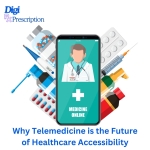
Why Telemedicine is the Future of Healthcare Accessibility
The healthcare industry is undergoing a massive transformation, and telemedicine stands at the forefront of this change. With its ability to bridge geographical, financial, and logistical gaps, telemedicine is revolutionizing how patients access care. By leveraging digital platforms and real-time communication technologies, telemedicine makes healthcare more accessible, efficient, and patient-centered.
This blog will explore why telemedicine is shaping the future of healthcare accessibility, particularly in regions with underserved populations or limited infrastructure.
1. Breaking Geographical Barriers
For patients living in remote or rural areas, access to healthcare facilities can be a significant challenge.
- Virtual Doctor Visits:
Telemedicine allows patients to consult with specialists and general practitioners from the comfort of their homes. - Rural Health Support:
It enables healthcare professionals to serve areas where hospitals or clinics are unavailable. - Emergency Consultations:
In critical situations, patients can receive immediate guidance from doctors without traveling long distances.
2. Making Healthcare Affordable
Healthcare costs often deter individuals from seeking timely medical attention.
- Lower Consultation Costs:
Telemedicine services are typically more affordable than in-person visits, making them accessible to low-income patients. - Reduced Travel Expenses:
Patients save on travel costs, which is particularly beneficial for those living far from medical facilities. - Preventive Care Savings:
Early diagnosis and treatment through telemedicine help avoid expensive emergency room visits.
3. Increasing Convenience for Patients
In a fast-paced world, convenience plays a significant role in healthcare accessibility.
- Flexible Scheduling:
Patients can book appointments at times that suit their schedules, including evenings and weekends. - Home-Based Care:
Elderly, disabled, or chronically ill patients can access care without leaving their homes. - Faster Access to Specialists:
Telemedicine eliminates long waiting times for specialist consultations.
4. Expanding Access During Emergencies
The COVID-19 pandemic highlighted the critical role telemedicine plays in maintaining healthcare accessibility during crises.
- Pandemic Response:
Telemedicine allowed patients to access care while minimizing the risk of virus exposure. - Natural Disasters:
During floods, earthquakes, or other disasters, telemedicine platforms provide uninterrupted care. - Public Health Campaigns:
Governments and organizations use telemedicine to deliver widespread healthcare services during public health emergencies.
5. Enabling Personalized and Continuous Care
Telemedicine is not just about consultations—it also fosters long-term patient-doctor relationships.
- Chronic Disease Management:
Patients with conditions like diabetes or hypertension can have regular virtual check-ups to manage their health effectively. - Follow-Up Care:
Doctors can monitor patients’ recovery and provide guidance remotely, reducing hospital visits. - Health Monitoring Tools:
Wearable devices integrated with telemedicine platforms allow doctors to track patients' vital signs in real-time.
6. Promoting Health Equity
Healthcare disparities often result from unequal distribution of resources. Telemedicine helps level the playing field.
- Access for Underserved Communities:
Telemedicine reaches populations that face barriers to traditional healthcare, such as migrants or minorities. - Language and Cultural Adaptations:
Platforms can be customized to accommodate diverse languages and cultural preferences. - Scalable Solutions:
Telemedicine can serve large populations with limited resources, ensuring equitable access.
7. Driving Technological Advancements in Healthcare
Telemedicine is powered by cutting-edge technologies that enhance healthcare delivery.
- AI-Powered Diagnostics:
Artificial intelligence assists doctors in diagnosing illnesses and recommending treatments. - E-Prescriptions:
Patients can receive prescriptions digitally, speeding up the treatment process. - Data Analytics:
Telemedicine platforms use analytics to identify trends, optimize treatment plans, and improve patient outcomes.
8. Boosting Mental Health Accessibility
Telemedicine has also transformed mental healthcare, making it more accessible and less stigmatized.
- Anonymity and Comfort:
Patients can seek therapy or counseling without fear of stigma, as sessions can be conducted from their homes. - Crisis Support:
Telemedicine provides immediate mental health support during crises or emergencies. - Expanding Reach:
Therapists can connect with patients in underserved areas where mental health services are scarce.
9. Meeting the Needs of a Digital Generation
As technology becomes an integral part of daily life, patients expect healthcare to keep up.
- Mobile-First Approach:
Telemedicine apps ensure healthcare is always accessible through smartphones. - Tech-Savvy Patients:
Younger generations prefer digital-first solutions for their convenience and speed. - Real-Time Communication:
Features like video calls and instant messaging align with modern communication preferences.
10. A Global Movement Toward Digital Healthcare
Telemedicine is not just a trend—it’s a global movement shaping the future of healthcare.
- Government Initiatives:
Many countries are investing in telemedicine to improve public healthcare systems. - Private Sector Growth:
Healthcare providers and startups are innovating new telemedicine solutions to meet growing demand. - Sustainability:
Telemedicine reduces the environmental impact of healthcare by cutting down on travel and resource use.
Conclusion
Telemedicine is more than just a convenience; it’s a necessity for building a more inclusive, accessible, and efficient healthcare system. By breaking barriers, reducing costs, and leveraging technology, telemedicine ensures that healthcare is accessible to everyone, regardless of location or financial status.
As digital tools and connectivity improve, telemedicine will continue to transform the healthcare landscape, making quality care a reality for all.
